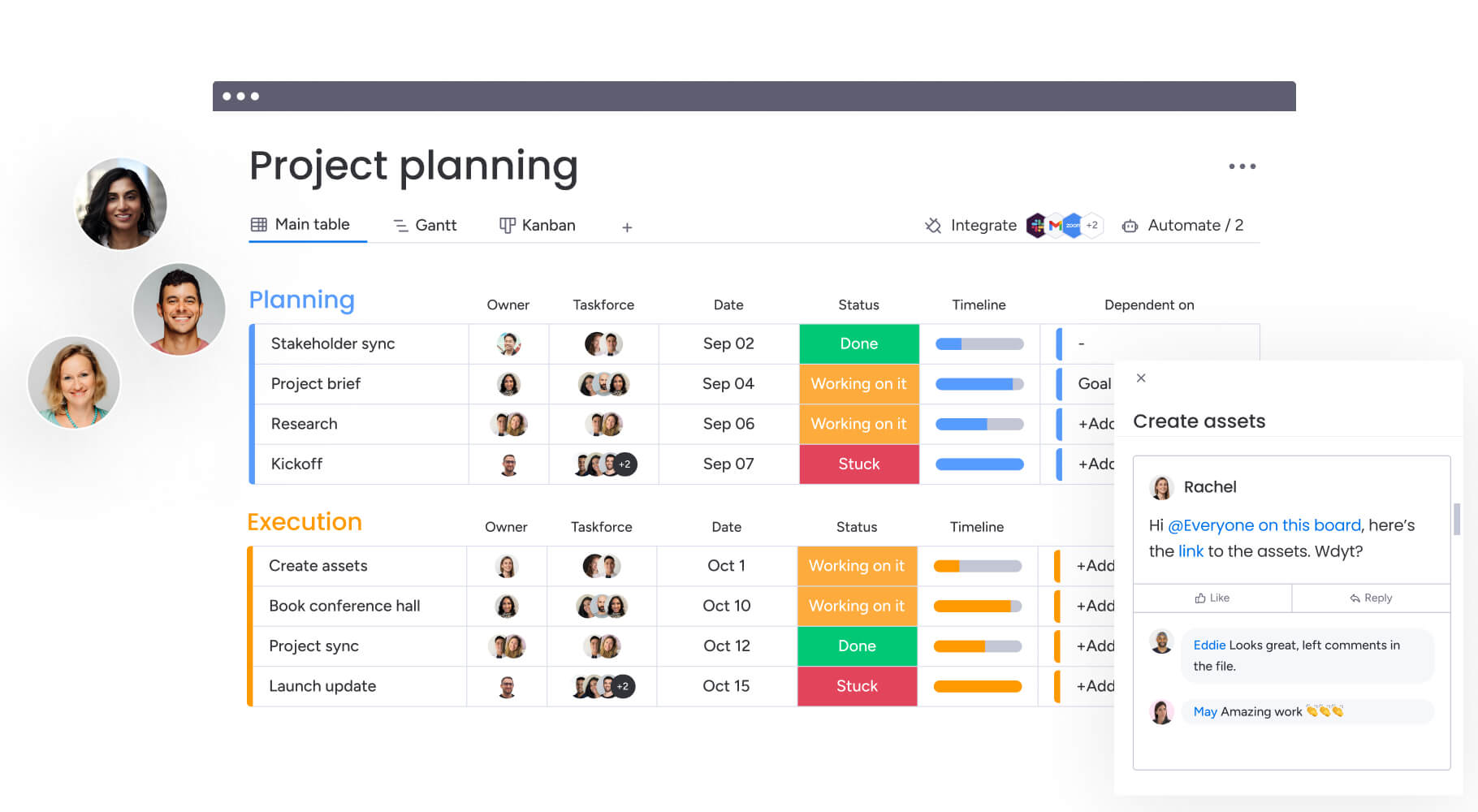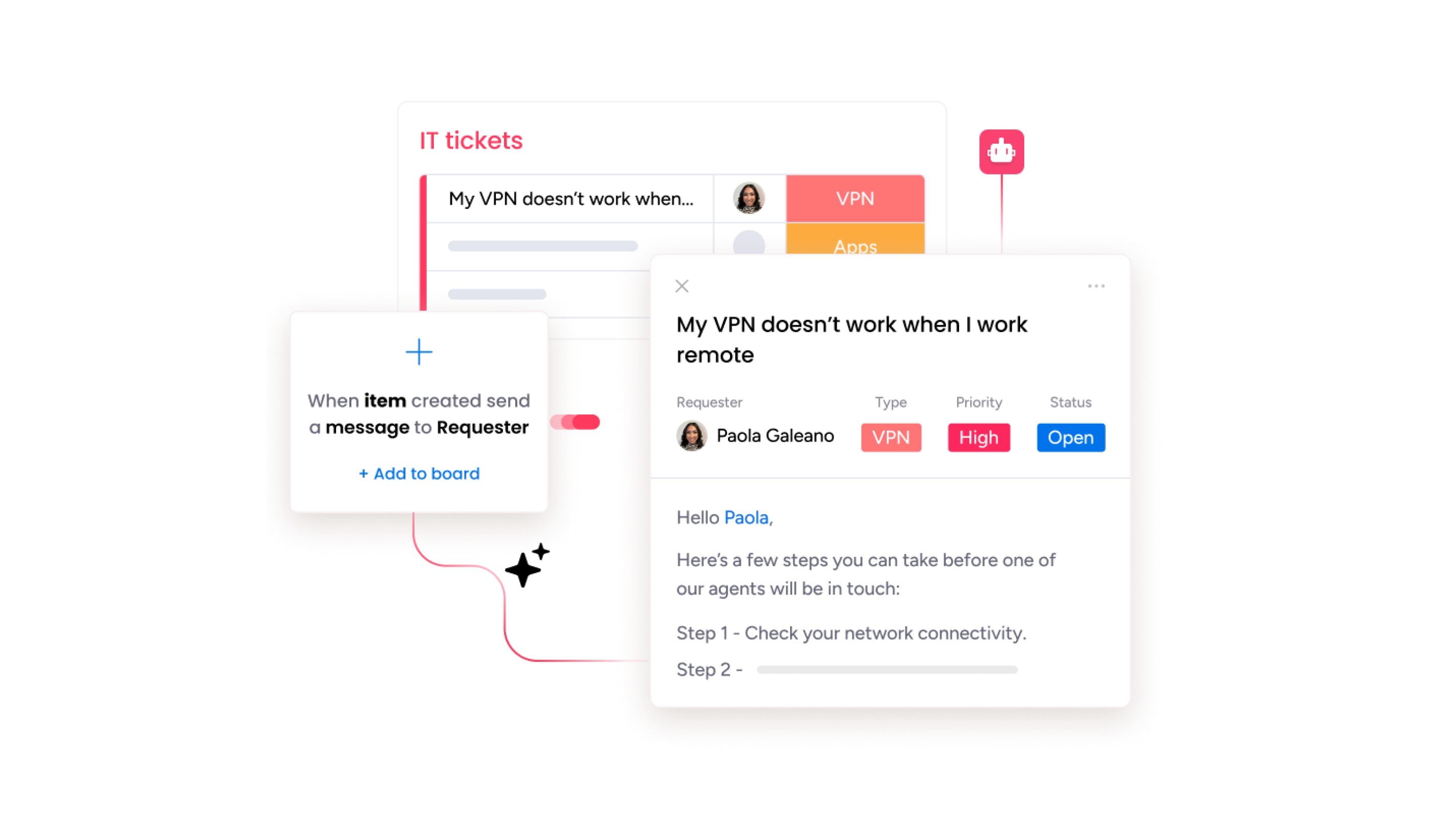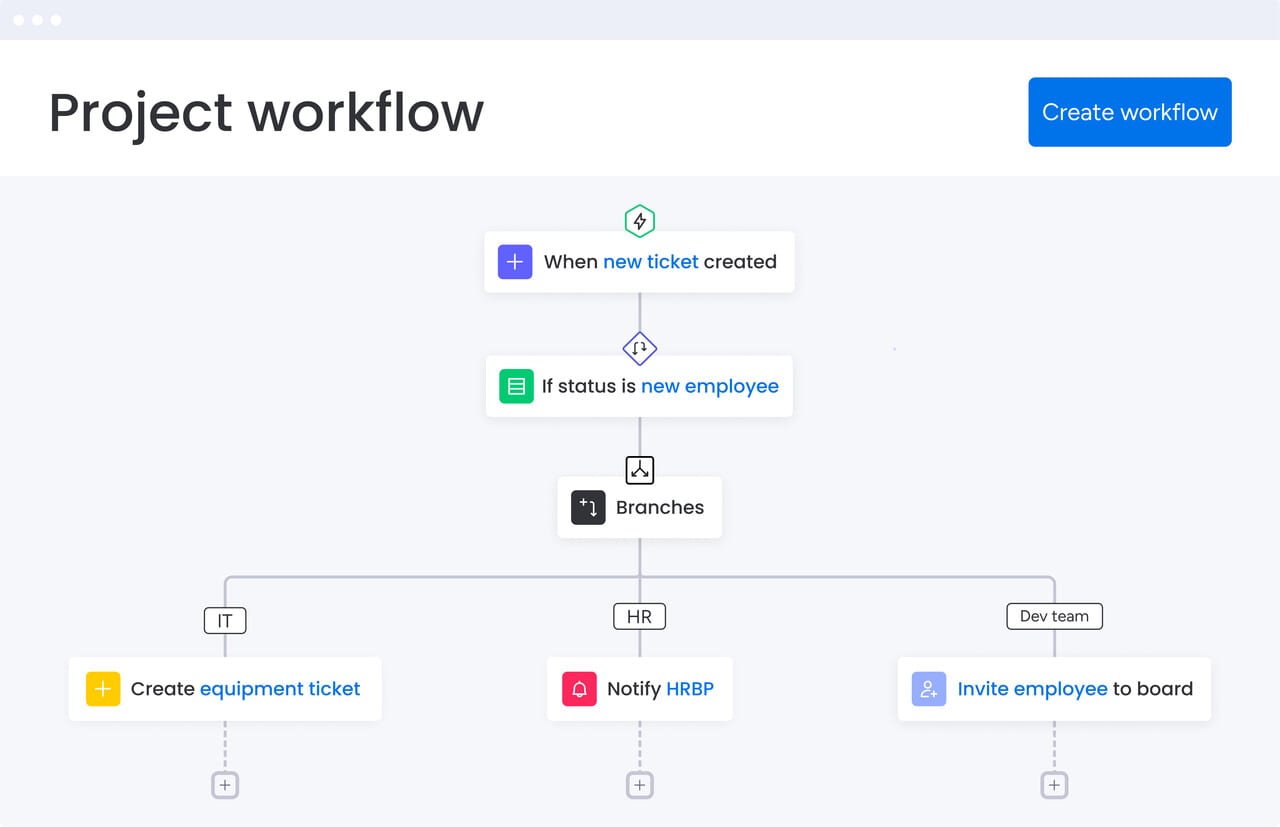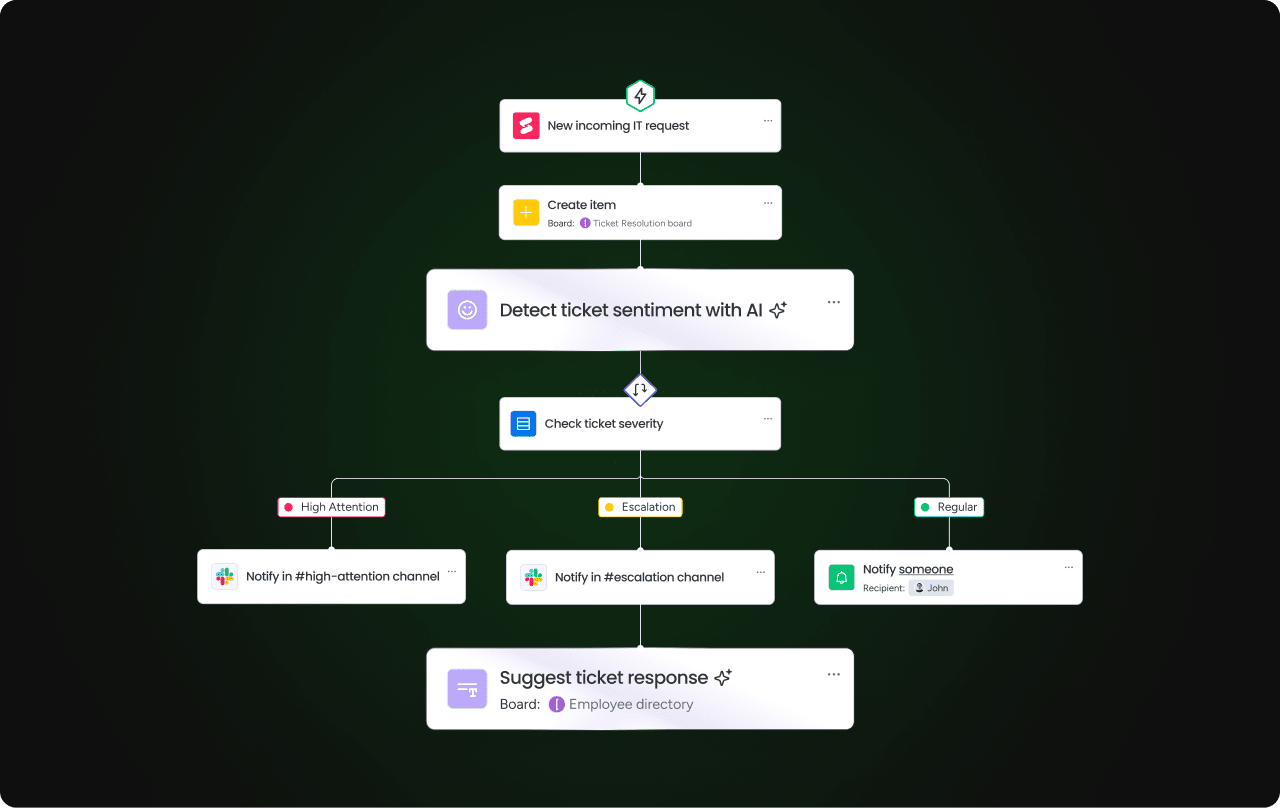As organizations scale, the small, repetitive tasks that once felt manageable can multiply into significant roadblocks. This operational friction slows down projects, creates inconsistencies, and pulls talented teams away from strategic work. The most effective teams overcome this by building systems that run themselves, ensuring work flows smoothly between people and departments without constant manual intervention.
This is where business process automation comes in. It provides a clear strategy for transforming those recurring activities into streamlined, digital workflows that boost speed and alignment.
This guide covers what business process automation is, its core benefits, and the steps to implement it successfully. We will also explore real-world examples and best practices for selecting the right software.
Try monday work managementWhat is business process automation (BPA)?
Business process automation (BPA) is the use of technology to execute recurring business processes or tasks where manual effort can be replaced with automated workflows. It centers on transforming repetitive, rule-based activities into streamlined digital processes that run with minimal human intervention.
In practice, modern BPA systems handle everything from simple data entry to complex cross-departmental workflows. The definition of business automation has evolved from basic scripts to sophisticated platforms that can make decisions, adapt to changing conditions, and integrate seamlessly across multiple systems.
How is BPA different from RPA and BPM
Understanding business process automation requires distinguishing between related technologies that serve different purposes. Each approach addresses specific automation needs within a comprehensive strategy.
BPA business process automation provides the strategic framework for automating business processes across entire organizations. These technologies work together to create comprehensive automation ecosystems where business process management automation ensures processes are optimized before implementation begins.
Which business processes can be automated?
What business processes can be automated depends on identifying activities that share common characteristics like being repetitive, rule-based, and high-volume. The most successful automation initiatives target business processes that can be automated while following predictable patterns.
Data entry and record updates
Automated data capture eliminates manual entry errors while accelerating information processing. Systems extract data from invoices, forms, and documents, then populate databases and update records across multiple platforms simultaneously.
Approval workflows
Multi-step approval processes benefit from automation through intelligent routing, automatic notifications, and escalation protocols. When approvals stall, automated systems redirect requests to backup approvers or notify supervisors.
Employee onboarding
Streamlined onboarding creates consistent experiences while reducing administrative burden. Automated systems collect required documents, create user accounts, schedule training sessions, and track completion status.
Organizations have identified numerous business processes that can be automated across multiple departments. These automation opportunities demonstrate what automates business processes most effectively:
- Financial processes: Invoice processing, expense approvals, budget tracking
- HR functions: Time tracking, leave management, performance reviews
- Customer service: Ticket routing, response templates, satisfaction surveys
- Marketing workflows: Campaign approvals, content scheduling, performance reporting

5 benefits of automating your business processes
The advantages of business process automation extend beyond simple efficiency gains. Organizations implementing comprehensive BPA automation strategies experience transformational changes that impact both operational performance and competitive positioning.
Reduced manual tasks
Automation liberates employees from repetitive work, enabling them to focus on strategic initiatives and creative problem-solving — echoing our findings from the monday.com World of Work Report that 80% of Millennials believe AI can help them do their jobs better. Teams report higher job satisfaction when freed from mundane activities that previously consumed their time.
Consistent compliance
Automated business processes enforce regulatory requirements systematically and maintain comprehensive audit trails. This consistency becomes particularly valuable in heavily regulated industries where compliance risks can impact organizational reputation.
Faster cycle times
Removing bottlenecks accelerates process completion significantly. Automated workflows operate continuously, processing requests and moving work forward even outside business hours, improving both customer and employee satisfaction.
Real-time visibility
Business process automation provides instant access to process status, performance metrics, and bottleneck identification. Managers can monitor progress, identify issues early, and make data-driven decisions based on current information.
Enhanced collaboration
Automated workflows improve handoffs between teams and departments, reducing silos and improving coordination. When processes move seamlessly between groups, communication improves and accountability increases across the organization.
monday work management‘s automation capabilities enable organizations to realize these benefits through intuitive workflow design that requires no coding expertise, making advanced automation accessible to teams across all departments.

7 steps to implement a business process automation strategy
A methodical business process automation methodology ensures successful adoption regardless of organization size. This business process automation strategy framework provides structure while allowing flexibility to accommodate unique business requirements.
Step 1: Identify repetitive work
Audit current processes to identify high-volume, rule-based activities that consume significant time and resources. Focus on activities that follow predictable patterns and require minimal creative decision-making.
Step 2: Map current processes
Document existing workflows thoroughly before automating them, including decision points, exceptions, and handoff procedures. This mapping reveals opportunities that should be addressed before automation begins.
Step 3: Define clear goals
Establish specific, measurable objectives for each automation initiative. Clear goals enable teams to evaluate success and make necessary adjustments during implementation.
Step 4: Select your business process automation software
Evaluate business process automation tools based on ease of use, integration capabilities, scalability, and alignment with organizational needs. The right business process automation solution should accommodate both current requirements and future growth.
Step 5: Pilot and test
Start with controlled implementations using small-scale pilots before full deployment. Testing reveals potential issues and allows teams to refine processes before organization-wide rollout.
Step 6: Train teams and integrate
Provide comprehensive training that emphasizes how automation supports rather than replaces human work, as the World of Work Report shows 60% of employees believe better training would improve change management. Effective change management ensures smooth adoption and maximizes automation benefits.
Step 7: Monitor and optimize
Continuously measure performance and refine automated processes based on real-world results. Regular optimization ensures automation continues delivering value as business needs evolve.
monday work management simplifies these business process automation steps through visual interfaces that make complex process automation accessible to business users.
Try monday work managementExamples of successful business process automation
These examples of business process automation illustrate how automation transforms common business activities into streamlined operations, across departments and industries.
Invoice processing
This business process automation example shows how systems capture data from incoming invoices, route them for appropriate approvals, match them with purchase orders, and schedule payments. This end-to-end automation reduces processing time from days to hours.
Customer support ticket escalation
Intelligent ticket routing automatically assigns support requests based on issue type, customer priority, and agent expertise. When tickets remain unresolved beyond specified timeframes, automated escalation ensures critical issues receive immediate attention.

Marketing campaign approvals
Campaign approval workflows automatically route creative assets through review cycles, track feedback and revisions, verify budget approvals, and coordinate launch activities. This automation ensures campaigns launch on schedule while maintaining quality standards.
monday work management enables organizations to build these automated workflows using visual, no-code interfaces that make complex process and automation accessible to business users without technical expertise.

Selecting the right business process automation software
Choosing the appropriate business process automation tool determines long-term success and organizational adoption. The right business process automation solution should align with specific business needs while integrating seamlessly with existing technology ecosystems.
Essential features distinguish effective business software automation platforms from basic process automation tools. Cloud business process automation capabilities ensure accessibility and scalability for growing organizations.
When evaluating business process automation platforms, here’s what really matters:
- Intuitive interface: No-code capabilities that empower business users to build workflows independently
- Flexible workflow design: Ability to model complex processes with conditional logic and exception handling
- Integration capabilities: Pre-built connectors to existing systems and robust API support
- Scalability: Capacity to grow with automation needs and handle increasing process volumes
- Analytics and reporting: Comprehensive visibility into process performance and optimization opportunities
monday work management exemplifies these essential features through visual workflow builders that make automation accessible to everyone. The platform’s flexible architecture supports everything from simple task automation to complex cross-departmental business process workflow automation.
Best practices to sustain automated business processes
Successful automation requires ongoing attention and continuous refinement. Organizations that treat automation business as a journey rather than a one-time project achieve the most significant long-term benefits.
Conduct regular audits
Periodically review automated business processes to identify process improvement opportunities, address changing business requirements, and optimize performance based on accumulated data and user feedback.
Perform ongoing training
Continuous education ensures teams can fully leverage automation capabilities as they evolve. Regular training sessions help users discover new features and optimization techniques that enhance their automation business process management.
Use AI-driven enhancements
Artificial intelligence can further optimize the automation of business processes through pattern recognition, predictive analytics, and adaptive decision-making that improves over time based on historical data.
monday work management’s AI Blocks enable teams to generate content, summarize information, and extract key insights directly within workflows, while Digital Workers function as virtual team members that autonomously complete routine tasks 24/7.
These capabilities adapt over time based on feedback and usage patterns, continuously refining their performance to deliver more accurate results and smarter process recommendations — all without requiring technical expertise from users.

Transform your operations with smarter business process automation
Business process automation transforms how organizations operate by eliminating repetitive work, ensuring consistent execution, and enabling teams to focus on strategic initiatives that drive growth. What is an automated business? It’s an organization that leverages technology to automate a business systematically, creating competitive advantages through operational excellence.
Modern business operations automation solutions like monday work management democratize automation by providing visual, intuitive interfaces that enable any team member to build sophisticated workflows. This accessibility ensures automation benefits reach every department and process within the organization, transforming how leaders orchestrate work across their entire enterprise.
Try monday work managementFrequently asked questions about business process automation
What is the difference between RPA and business process automation?
Business process automation (BPA) focuses on end-to-end workflows across departments, while robotic process automation (RPA) handles specific repetitive tasks using software robots that mimic human actions on computer systems.
How does AI enhance business process automation capabilities?
AI enhances business process automation by adding intelligent capabilities like pattern recognition, natural language processing, and predictive analytics that allow systems to handle complex decisions and continuously improve performance over time.
What characteristics make a business process suitable for automation?
Business processes ideal for automation are typically repetitive, rule-based, consistent, high-volume, and mature, with well-defined inputs and outputs that follow predictable patterns without requiring creative decision-making.
How long does implementing business process automation typically take?
Business process automation implementation timelines vary based on complexity, but organizations can see results in as little as a few weeks for simple processes when using modern no-code platforms with pre-built templates and workflows.
How do you measure the ROI of business process automation initiatives?
Measuring business process automation ROI involves tracking metrics like time saved, error reduction, labor costs, compliance improvements, and customer satisfaction before and after implementation to quantify tangible business impact.
Can small businesses benefit from business process automation solutions?
Small businesses can significantly benefit from business process automation by implementing scalable solutions that address their most time-consuming tasks, allowing limited staff to focus on growth activities rather than administrative work.
 Get started
Get started 

